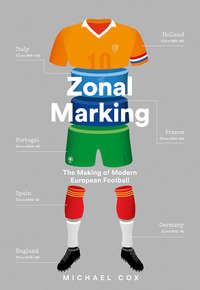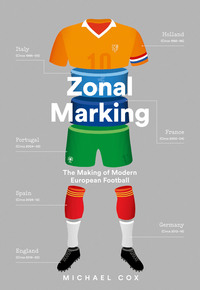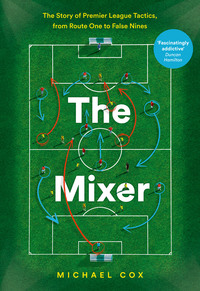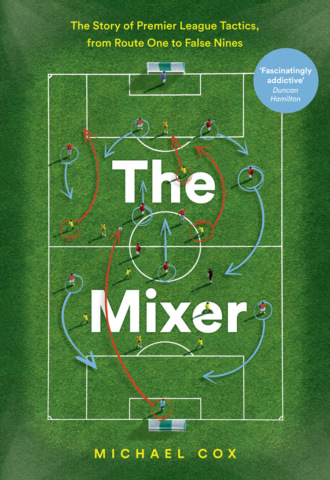
Полная версия
The Mixer: The Story of Premier League Tactics, from Route One to False Nines

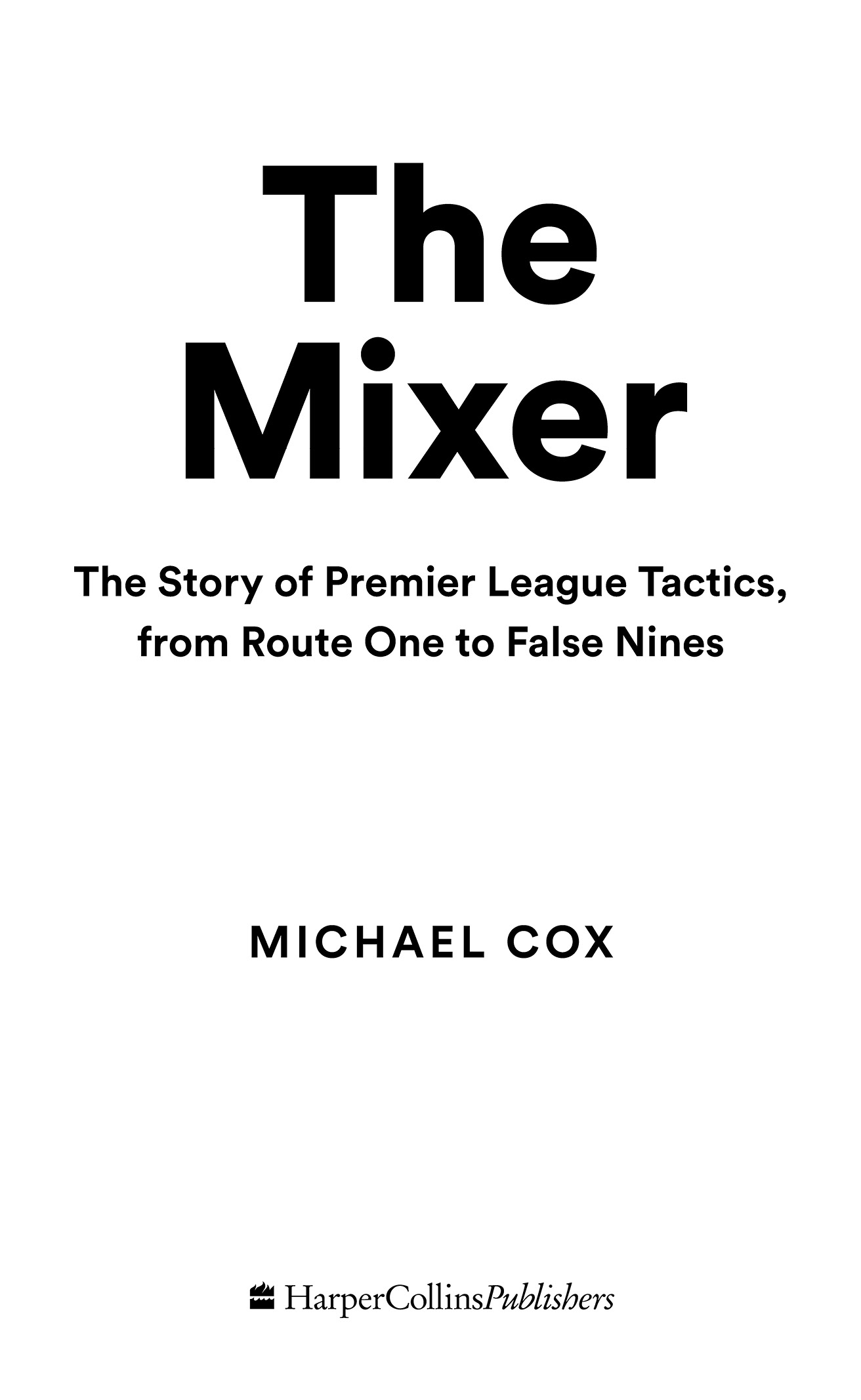
Copyright
HarperCollinsPublishers
1 London Bridge Street
London SE1 9GF
www.harpercollins.co.uk
First published by HarperCollinsPublishers 2017
FIRST EDITION
© Michael Cox 2017
Cover design Simeon Greenaway © HarperCollinsPublishers 2017
Cover photographs © Shutterstock.com, DariuszPa/Getty Images
A catalogue record of this book is available from the British Library
Michael Cox asserts the moral right to be identified as the author of this work
All rights reserved under International and Pan-American Copyright Conventions. By payment of the required fees, you have been granted the nonexclusive, non-transferable right to access and read the text of this e-book on screen. No part of this text may be reproduced, transmitted, downloaded, decompiled, reverse engineered, or stored in or introduced into any information storage retrieval system, in any form or by any means, whether electronic or mechanical, now known or hereinafter invented, without the express written permission of HarperCollins e-books.
Find out about HarperCollins and the environment at
www.harpercollins.co.uk/green
Source ISBN: 9780008215552
Ebook Edition © June 2017 ISBN: 9780008215569
Version: 2017-12-02
Contents
Cover
Title Page
Copyright
Introduction
Part One – In the Beginning
1 A Whole New Ball Game
2 Cantona & Counters
3 The SAS & The Entertainers
Part Two – Technical Progress
4 Between the Lines
5 Arsènal
6 Speed
Part Three – Expansion
7 Euro Progress & Squad Rotation
8 The Foreign Revolution
9 Big Sam & Long Balls
Part Four – Universality
10 One Up Front
11 Invincibles & Convincibles
12 The Makélélé Role
Part Five – Reactive Strategy
13 Iberian Influence I
14 Iberian Influence II
15 The Midfield Trio
Part Six – Direct Attacking
16 Roonaldo
17 A Wet and Windy Night at Stoke
18 Inverted Wingers
Part Seven – Possession
19 The Italian Job
20 Tiki-Taka
21 Assisters & False Nines
Part Eight – Post-possession
22 Rodgers’ Reversal
23 Pressing Issues
24 Leicester
25 Three at the Back
Postscript
Bibliography
Acknowledgements
Index
About the Publisher
Introduction
‘Get it in the mixer!’
These five words represent the simplest tactic in football: launch the ball into the penalty box, take advantage of the ensuing chaos, perhaps following a goalmouth scramble, and hope to pinch a scruffy goal.
It’s an approach rightly ridiculed today, but as recently as the 1980s it was English football’s most popular tactic. During this period tactical thinking was influenced heavily by Charles Hughes, the Football Association’s director of coaching, who clumsily employed statistics to illustrate the value of launching the ball quickly downfield. He effectively formulated English football’s national coaching curriculum, as well as working alongside England managers Bobby Robson, who was sceptical about Hughes’s methods, and Graham Taylor, who was altogether much keener.
Hughes was obsessed with players thumping the ball into the ‘position of maximum opportunity’ (POMO) – inside the box, level with the far post – as often as possible. Hughes did have other, more sophisticated ideas, but his obsession with POMO dominated, and harmed, English football by creating predictable, simplistic teams and one-dimensional, brain-dead players. At the time of the Premier League’s formation in 1992, therefore, English football was considered to be about long balls, about route one, about POMO, about getting it in the mixer.
But this was a darker period for more significant reasons, as an overwhelming hooligan problem meant English football was derided both in the national media and across Europe. The nadir came with the 1985 European Cup Final at the Heysel Stadium in Belgium, when Liverpool supporters charged at Juventus fans, resulting in 39 people being killed by a collapsing wall. English clubs were subsequently banned from European competition for five years, and English footballing culture, traditionally slow to embrace tactical innovations from abroad, consequently became even more insular.
There were other tragedies. A fortnight before the Heysel disaster, 56 people were killed at Bradford City’s Valley Parade by a fire that engulfed an entire stand within minutes. Four years later, grave policing errors at Hillsborough resulted in the deaths of 96 people, a tragedy subsequently blamed, consistently and incorrectly, upon supporters.
In the aftermath of the Bradford fire a leading article in the Sunday Times described football as ‘a slum sport played in slum stadiums, increasingly watched by slum people’. It was a desperately distasteful description, but serves as a useful low-water mark for measuring English football’s subsequent development. Slum people? The problem of hooliganism was largely defeated in the years that followed. Slum stadiums? The Taylor Report recommended all-seater grounds, and the Premier League’s formative years were dominated by new or dramatically renovated stadiums. Slum sport? English football changed enormously during the Premier League era, its popularity rising dramatically, first within England and then across the world.
While the Premier League was identical in its basic sporting structure to its predecessor, the old First Division, England’s top flight benefited from something of a rebrand considering the aforementioned problems, and 1992 isn’t an entirely arbitrary start date for football’s modern age – as explained in the opening chapter.
The concept of the Premier League enabled top-flight clubs to gain independence from the Football Association and the Football League, allowing them to negotiate lucrative broadcast and sponsorship contracts. The broadcasting aspect proved most significant; a bidding war between ITV and Sky ensued, with the latter securing TV rights in a move that completely transformed its previously loss-making satellite subscription service. Incidentally, Manchester United manager Alex Ferguson was one of the fiercest critics of the Premier League, ridiculing the concept as a ‘piece of nonsense’ that would ‘sell supporters down the river’. But Ferguson would define the division more than anyone, winning 13 of the first 21 titles before his retirement in 2013.
This book isn’t an account of the Premier League’s business development, but it’s impossible to ignore the extraordinary surge in TV revenue. The Premier League received £51m per season in broadcasting rights between 1992 and 1997, then considered an astounding amount. This sum increased exponentially over the next two decades, reaching £2.75bn per season by 2016, 50 times more than in 1992. Sky were effectively paying over £11m to screen each live match, a staggering figure when you consider rights to the entire final old First Division season cost less than £15m. A division essentially created to provide televisual entertainment has proved successful beyond anyone’s wildest dreams.
It’s worth remembering, too, that these figures weren’t plucked out of thin air. Broadcasters could justify paying these eye-watering sums because of the huge public demand, which was fuelled by the Premier League becoming such a fantastic spectacle, the world’s most thrilling league. Set against the dark days of the 1980s, it represents an incredible turnaround. How did the football – the ‘product’, as the marketing men would say – become quite so good?
This book seeks to explain how. Although the 25 years are represented by 25 chapters, this is a thematic rather than a literal season-by-season account. The focus is upon the revolutionaries: the innovative managers, the game-changing players, the inspirational teams, the new tactical concepts, the off-field developments that influenced playing styles. The story is about the Premier League becoming universal, in two different ways.
First, it became universal on a tactical level. In the early 1990s there were very specific demands for every position – defenders simply defended, attackers simply attacked. But gradually positions became more all-encompassing, with defenders expected to start attacking moves and attackers encouraged to start defensive pressure. Players were increasingly all-rounders rather than specialists.
Second, it also became universal on a geographical basis, as English clubs broadened their horizons and became increasingly dependent upon foreign players and managers. Amazingly, on the Premier League’s opening weekend in August 1992, just 11 foreign players started for the 22 clubs combined, and there were no foreign managers. By its 25th season, the majority of Premier League players and managers were foreign – and almost every major footballing nation on earth was represented. Of the top 25 countries in the FIFA rankings, only Mexico didn’t have a Premier League representative in 2016/17.
The combination of these two factors saw Premier League sides abandon ugly, straightforward, direct football and embrace a more cultured, continental, technical style. This is the story of the Premier League’s remarkable tactical evolution – from pie to paella, from route one to false nines.
Part One
1
A Whole New Ball Game
‘The back-pass law is the best rule change ever – it has changed the game.’
Peter Schmeichel
We are constantly reminded that ‘football didn’t start in 1992’ in response to Premier League-centric historical records, but 1992 effectively marked the beginning of modern football. It was the beginning of a new, exciting, more entertaining era of the game, the watershed moment that prompted sweeping changes to create a more fast-paced, technically proficient sport.
However, it had absolutely nothing to do with the formation of the Premier League.
The introduction of the back-pass law in 1992 had a transformative effect upon football. Not since 1925 – when the offside law was altered so that only two opponents, rather than three, needed to be goalside of an attacker – had a law change been so effective at improving the spectacle of the world’s most popular sport. There have been minor alterations to the Laws of the Game during the Premier League era: different interpretations regarding offside, stricter laws governing tackles, revisions to kick-off. But 1992 was literally a game-changer.
The law change was simple. Previously, goalkeepers were allowed to use their hands if the ball was deliberately kicked to them by a teammate. Now, they were not. They could still handle the ball if a teammate headed, chested or even kneed it back, and throw-ins back to the goalkeeper could be picked up until 1997, but goalkeepers were forced to use their feet more than ever before, effectively becoming part of passing moves.
There was an extremely good reason for the law change. Hitherto, teams could time waste infuriatingly when leading matches; the goalkeeper would roll the ball out, the defenders would retain possession until an opponent challenged, then return the ball to the goalkeeper, who would pick it up and restart the process. It was often very tedious, and in hindsight it’s incredible that any team ever contrived to lose a lead. The ultimate example came in the dying seconds of Rangers’ European Cup first round tie against Dynamo Kiev in 1987. With Rangers 2–1 ahead on aggregate and building an attacking move, midfielder Graeme Souness received the ball midway inside the opposition half, immediately turned towards his own goal and thumped a 70-yard backward ball to his goalkeeper Chris Woods. Souness, incidentally, would later suffer from the back-pass change more than most.
Examples of negative play became particularly obvious at the 1990 World Cup, a tournament so dreadfully negative that FIFA felt compelled to take action. The new law came into effect two years later, in time for the inaugural Premier League campaign.
While some managers, like Luton Town’s David Pleat, spoke in favour of the change, there was a significant backlash from most top-flight managers, including the last two title-winning bosses. ‘I don’t think this is going to enhance the game at all,’ complained Arsenal’s George Graham, while Howard Wilkinson, who had taken Leeds United to the final pre-Premier League title in 1991/92, suggested the new laws would simply encourage long-ball football. ‘If the new rule is the authorities’ idea of how to foster better football, then the experiment will prove counter-productive,’ he declared. ‘The new ruling will be manna from heaven to a coach working with his long-ball side.’
Wilkinson predicted teams would concentrate on pumping long balls in behind the opposition and use a ‘goalie-blocker’, lingering in an offside position, to intercept potential back-passes from defenders to the goalkeeper’s feet, forcing them to hack the ball into touch instead. ‘FIFA have inadvertently encouraged more long-ball football,’ he maintained. ‘This isn’t a mad, scientific nightmare, this is the reality as stipulated by the overlords of the world game.’ Wilkinson’s view, that route one football would become dominant, found support from many managerial colleagues.
But the back-pass law served its initial purpose, and teams were no longer able to time waste so blatantly. Wilkinson’s predictions about long-ball football weren’t entirely inaccurate immediately following the law change – Leeds’s matches in a pre-season friendly tournament against Stuttgart and Sampdoria were notable for the opposition repeatedly playing hopeful balls in behind the Leeds defence, hoping for errors – but he failed to foresee how goalkeepers and defenders would adjust and gradually become comfortable in possession, creating a more technically advanced sport.
There were significant knock-on effects. Teams had a greater incentive to press in advanced positions, forcing defenders into mistakes, and managers were less inclined to play stiflingly aggressive defensive lines, because covering the space in behind now involved playing out of trouble. As a result the game became stretched, which created more room in midfield. Arguably the biggest change was in the speed of matches – players had previously become accustomed to breaks in play while goalkeepers held onto the ball. Suddenly the action had become non-stop.
These developments, the consequence of one simple law change, played into the hands of the Premier League, a division created specifically to provide televisual entertainment. Sky Sports introduced plenty of innovations, including a simple idea that has become universally established: displaying the score and clock on the top-left of the screen. Other Sky gimmicks were less successful: pre-match firework displays were scrapped after a stray rocket was launched out of The Dell and into a nearby petrol station, while the use of cheerleaders was short-lived, possibly after concerns from the presenter over their understanding of the offside rule. But none of this artificial razzmatazz was as crucial as the back-pass law in making the Premier League a fantastic show, and Sky were hugely fortunate that world football took an enormous step forward ahead of 1992/93. Without this significant improvement in the spectacle of matches, the Premier League wouldn’t have developed into the multi-billion-pound product it is today.
While supporters quickly realised the benefit of the back-pass change, many players found themselves exposed. The impact was first noticed in pre-season, when Manchester City goalkeeper Andy Dibble suffered a broken leg in a friendly against a League of Ireland XI, struck by sudden indecision as a slow back-pass approached, eventually attempting to tackle the opposition striker. ‘I wasn’t sure whether to kick the ball or pick it up,’ Dibble complained, describing himself as ‘the first victim’ of the law. However, defenders struggled more than keepers, and the Premier League’s opening day, 15 August 1992, was a comedy of errors.
Fourteen minutes into Leeds’s 2–1 victory over Wimbledon, Dons right-back Roger Joseph panicked inside his own penalty box, caught in two minds – should he pass back to goalkeeper Hans Segers or simply clear the ball? Eventually he did neither, scuffing the ball barely two yards, allowing Leeds’s Lee Chapman to pounce – and presumably leaving Leeds manager Wilkinson unsure whether he should celebrate or ruefully shake his head at the ‘reality as stipulated by the overlords of the world game’. Down at Highbury, Norwich recovered from 2–0 down to defeat Arsenal 4–2, a victory secured with a classic example of back-pass confusion. Norwich launched a high pass into the opposition half, forcing Arsenal captain Tony Adams to deal with a bouncing ball. He nervously glanced back to his goalkeeper, realised David Seaman didn’t want the ball, so instead attempted a square pass to centre-back partner Steve Bould. But Adams missed the ball completely and stumbled, allowing Mark Robins to steal in and chip Seaman, scoring the goal that ensured Norwich were the Premier League’s first-ever leaders.
Both goals in Chelsea’s 1–1 draw with Oldham at Stamford Bridge were related to the back-pass law: Oldham centre-back Ian Marshall, troubled by his inability to play the ball back to his keeper, slipped when attempting to control a long ball and allowed Mick Harford to open the scoring. But then Chelsea goalkeeper Dave Beasant, having received the ball from a defender, scuffed his kick, allowing Nick Henry to equalise. The new rules were causing chaos.
There was also a ‘positive’ goal scored from the back-pass rule, however. Sheffield United’s Brian Deane had headed the Premier League’s opening goal against Manchester United, then scored another from the penalty spot. This second arose because Blades midfielder John Gannon looked set to play a back-pass, saw an opponent making a run to intercept his potential pass (although he wasn’t quite a ‘goalie-blocker’) and so turned his way out of danger before playing a left-footed pass into the channel. Striker Alan Cork raced onto it, was tripped by Gary Pallister, and Deane converted the penalty. There were just seven seconds from Gannon’s turn until the penalty award – without the new law, the ball would still have been in the goalkeeper’s hands at the opposite end.
Compilers of ‘football’s funniest gaffes’ VHS tapes must have been delighted. The most comical error came in early September at Tottenham, and resulted in the dismissal of Sheffield United goalkeeper Simon Tracey. He’d already been booked for handling the ball outside the box, and then, when presented with a back-pass in the second half, panicked. He was closed down quickly by Spurs’ Paul Allen, and proceeded to dribble the ball sideways, taking it directly out of play for a Tottenham throw. When Tracey tried to retrieve the ball from next to the advertising hoardings to prevent Spurs taking the throw, a quick-thinking ball boy snatched it away, chucked it to Spurs sub Andy Gray, which prompted Tracey to rugby-tackle Gray to the floor. He was dismissed. Blades manager Dave Bassett wasn’t impressed. ‘He’s got the brains of a rocking-horse – and I told him so.’
This was not simply an English phenomenon, of course, and there were similar problems across Europe. North of the border, Rangers opened the scoring in October’s Scottish League Cup Final when Aberdeen goalkeeper Theo Snelders bizarrely chested a wayward clearance from a teammate straight into the path of a grateful Stuart McCall. It wasn’t an intentional back-pass anyway, and wouldn’t have been penalised, but Snelders was clearly unaware of the regulations and was left screaming at his defenders, ‘I can’t pick it up!’ The biggest impact came in Italy. Serie A was traditionally Europe’s most defensive division, and following goals-per-game averages of 2.11, 2.24, 2.29 and 2.27 in the four seasons before 1992/93 it suddenly jumped to 2.80, an unprecedented rise. The Premier League didn’t witness such a surge, rising from 2.52 in the final old First Division season to 2.65 in the opening Premier League campaign, but the back-pass law clearly affected the nature of the division, with certain teams particularly struggling.
The most famous victims were Liverpool. Many have linked their inability to win a Premier League title, having dominated the 1970s and 1980s, to the introduction of the back-pass law. In reality they finished sixth in both the final First Division season and the first Premier League season, but Liverpool’s players admit it affected them badly. ‘It was constantly in your mind as a defender – you can’t play the ball back,’ remembered defender Nick Tanner. ‘Previously, Liverpool would just kill the game off. We’d be 1–0 up, play the ball back to Bruce Grobbelaar. He’d bounce the ball a bit, Phil Neal would drop off, and Bruce would roll it out to him. That all stopped.’ Their manager during this period was Souness – the man responsible for the back-pass to end all back-passes.
Arsenal also suffered. They were the bookmakers’ title favourites, having scored the most goals in the top flight during 1991/92, but they struggled to build play from deep and scored the fewest goals during 1992/93, underlining the extent of the back-pass change. However, they adapted well defensively and remained an excellent side in knockout competitions, winning the League Cup and FA Cup – both, coincidentally, with 2–1 victories over Sheffield Wednesday.
But the biggest losers, significantly, were a very direct side – Wilkinson’s Leeds. Having triumphed the previous season, they slipped backwards alarmingly and finished 17th in the Premier League’s inaugural campaign, failing to win away all season. Considering that Wilkinson predicted route one football would prosper under the new regulations, it was ironic that his own players suffered precisely because they could no longer play that way. Goalkeeper John Lukic became the first Premier League goalkeeper to be penalised for handling a back-pass, from centre-back Chris Whyte – whom Wilkinson had rated as the division’s best centre-back in the previous campaign but who struggled considerably with modern football. ‘The back-pass law affected us particularly,’ midfielder Gary Speed later admitted. ‘The centre-backs used to stroke the ball back to the goalkeeper, and John Lukic used to launch it up to me and Lee Chapman. Suddenly we weren’t allowed to play that way anymore.’
Fellow midfielder Steve Hodge agreed. ‘Previously John Lukic would hold the ball and he’d launch it to us high up the pitch,’ he explained. ‘Now, Lukic would have to launch it from the floor and the ball wasn’t going far enough down the pitch. We were much less of a threat because the ball wasn’t landing or being flicked to the edge of our opponents’ area, it was bobbling around in the midfield. Also, teams would now really push up and made Lukic kick it quickly.’ It’s notable how much emphasis was placed upon the simple concept of how far the goalkeeper could kick, indicating the accepted method of distribution at the time.



